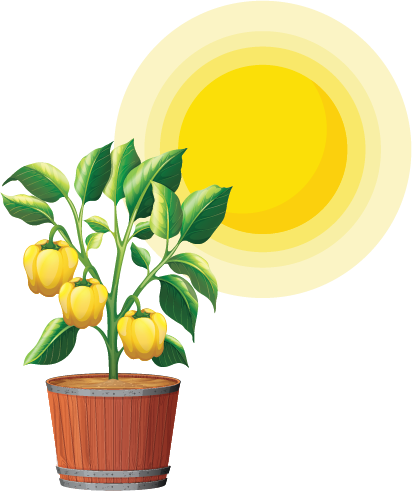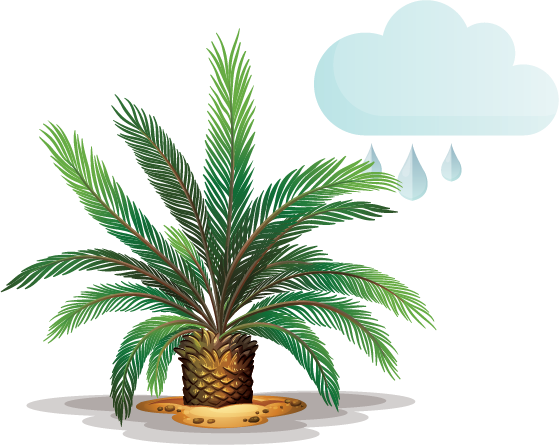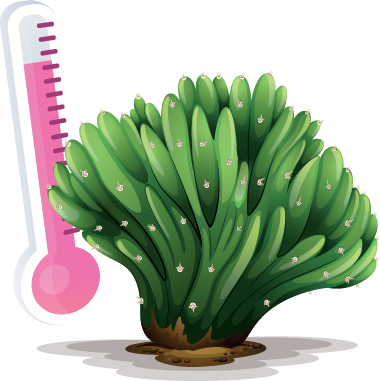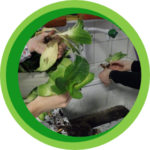Plant care
What do plants need to grow?

In order to thrive and grow optimally, various factors are indispensable for plants. Plant growth factors include light, air, temperature, water, and nutrients. If all factors are sufficiently present, the plant can develop well.
BENEFITS FOR GREEN COOL SCHOOLS

- Pupils learn how to care well for plants at school
- Enhance the understanding of good conditions for greenery ideas
- Save money by growing seedlings at school and caring well for school plants, keeping the greenery in good shape for a long time
Light
The sun is the most important source of energy for building up biomass and life processes in our universe. The sun’s energy is emitted into space in the form of electromagnetic radiation and hits the earth in different wavelengths. The human eye can usually perceive light in the wavelength range of 380 to 780 nanometres (nm). Just as the human eye has light perception and sensitivity, plants have their own special sensitivity curve for photosynthesis. Plants absorb part of the light in the wavelength range of 400 to 700 nm. Indoors so-called plant lights are often used so that the plants are sufficiently supplied with light and thus optimal growth is guaranteed.

Water
“Without water there would be no life.” – this sentence is fully justified, again and again. Water gets the plant’s circulation going; with the soil water the mineral salts dissolved in it are absorbed, which are needed in metabolism or growth. Water is indispensable for assimilation. Excess water is evaporated by the leaves – which helps to cool the environment. If there is too little watering, the plant wilts and can wither. If too much watering, the roots rot, the leaves turn yellow and eventually the plant dies.

Air
Plants need air, not only the leaves but also the roots! They absorb CO2 (carbon dioxide) and convert it back into oxygen. Sufficient pore volume is therefore important for the respiration of plant roots. This is expressed as a percentage of the total soil volume.
The ideal soil consists of approximately
If the soil is compacted, less water as well as oxygen is conducted into the soil. The conditions for the plant’s roots deteriorate as air exchange is missing.
Nutrients
Plants need a variety of nutrients to grow. A regular supply of nutrients should be ensured. This can be done with slow-release fertiliser (in granulate and powder form) or express fertiliser (liquid fertiliser or in powder form). The nutrients dissolved in water are mainly absorbed through the roots.
DID YOU KNOW?

Do plants need soil?
Plants do not necessarily need soil to grow, but they do need water, nutrients, and air. Soil merely serves as a “matrix” for roots to hold on to.
Soil and substrates are the nutrient medium on which plants of all kinds grow and find support. Substrates store water like a sponge and slowly release it to the plant roots, providing them with support. Technical substrates are usually lighter than soil, have a large pore volume and sufficient air capacity, but only store nutrients to a limited extent.
Temperature
Plants have adapted to a wide variety of site conditions. Native plant species are therefore also adapted to the temperature conditions. Since indoor plants are mainly native to the tropics and subtropics, they need constant temperatures of around 20°C and high humidity.

Humus
The humus layer of the soil is the most important habitat for plants. Humus is the dead organic matter in the top layer of soil. It is found under the litter layer, if present. Humus is formed by the decomposition of organic matter, such as plant or animal remains. Humus formation and decomposition depend on many different factors, such as climate, geology, plant cover, biological activity and land use.
DID YOU KNOW?

How thick is the humus layer?
In the temperate climate zone of the northern hemisphere, as is the case in Austria or Germany, the humus layer of fertile arable soil is around 30 to 40 cm. In the tropical rainforests, on the other hand, there are only a few centimetres. How come?
In climates with a seasonal climate, where temperatures are significantly lower and precipitation rates higher, especially in winter, soil activity is much lower. In the tropics, where there is a higher soil activity by animals and fungi, especially due to the higher temperatures, humus is decomposed much faster.
OPPORTUNITIES TO DEEPEN THE TOPIC ACROSS DISCIPLINES

As an interdisciplinary consolidation you can work on the following questions with the pupils:
What are the conditions in the region? What is the predominant climate zone?
Pupils analyse the site conditions in the region, on their school grounds and in the classroom.
- Prevailing climatic factors can be named and described.
How is the nutrient content of the soil related to yield? Do more nutrients always produce more yield? What should be considered when fertilising?
- Growth factors are discussed in terms of agriculture and yield, as well as how site conditions are being influenced by measures such as fertilising and irrigation.
The connection between climate change and neophytes can be discussed in biology and environmental studies lessons.
- Pupils can explain the term neophyte and give examples from the region. The teacher explains the topic of neophytes with examples. Reasons for the spread of neophytes are analysed and a connection to climate change is being established.
Experiments
Experiment: Grow your own seedlings
Some plants must be pre-cultivated before they are planted. A practical and cost-saving option is to grow plants from the seeds yourself. This way, in contrast to greenhouse plants, they are immediately adapted to the environmental conditions and are thus…


